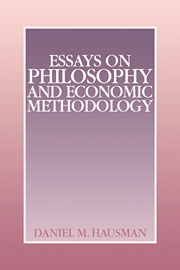Book contents
- Frontmatter
- Contents
- Introduction: What is philosophy of economics?
- PART I METHODOLOGY AND THEORY APPRAISAL
- PART II CAUSALITY IN ECONOMICS
- 9 Are there causal relations among dependent variables?
- 10 Classical wage theory and the causal complications of explaining distribution
- 11 Supply and demand explanations and their ceteris paribus clauses
- PART III CASES AND PUZZLES
- PART IV POSTSCRIPTS
- Bibliography of relevant writings by Daniel M. Hausman
- Bibliography of works by other authors
- Index
9 - Are there causal relations among dependent variables?
Published online by Cambridge University Press: 05 June 2012
- Frontmatter
- Contents
- Introduction: What is philosophy of economics?
- PART I METHODOLOGY AND THEORY APPRAISAL
- PART II CAUSALITY IN ECONOMICS
- 9 Are there causal relations among dependent variables?
- 10 Classical wage theory and the causal complications of explaining distribution
- 11 Supply and demand explanations and their ceteris paribus clauses
- PART III CASES AND PUZZLES
- PART IV POSTSCRIPTS
- Bibliography of relevant writings by Daniel M. Hausman
- Bibliography of works by other authors
- Index
Summary
This paper makes explicit and takes issue with the bizarre view, which is unfortunately prevalent among social scientists, that causal relations are features of models only. There are some good reasons to represent causal factors with independent variables. But the association between causes and independent variables is only a desideratum model construction. It is not a criterion for judging which things are causes and which are effects.
INTRODUCTION
We would like to have answers to many causal questions about our economy and our society. Do large budget deficits cause higher interest rates or increased inflation? Will controlling the money supply control inflation? What other effects will controlling the money supply have? Will a particular policy of preferential hiring lead to a change in the status of disadvantaged groups?
Economists and social scientists often employ mathematical models, especially linear equation systems, in attempting to answer questions like these. But these tools are imperfect and have often been misunderstood even by their makers. Causal relations are only weakly represented by mathematical functions, because it is difficult to represent the effectiveness or asymmetry of causality. Functional relations do not unambiguously imply the existence of causal relations. Tests which establish the correctness of various functional relations do not automatically establish the truth of any causal claims. The mathematical relations between the growth in the supply of money in a given period and the rate of inflation in another period can, for example, be just the same whether the growth in the money supply affects the rate of inflation, the rate of inflation affects the money supply, they are mutually dependent, or they are both effects of some common cause.
Information
- Type
- Chapter
- Information
- Essays on Philosophy and Economic Methodology , pp. 109 - 128Publisher: Cambridge University PressPrint publication year: 1992
